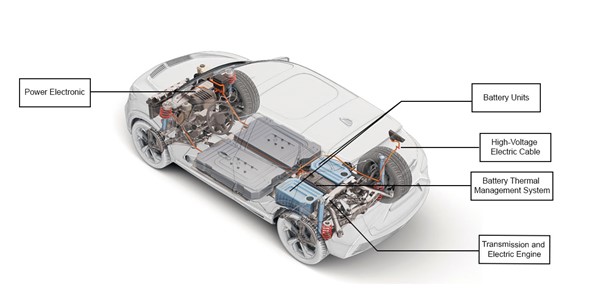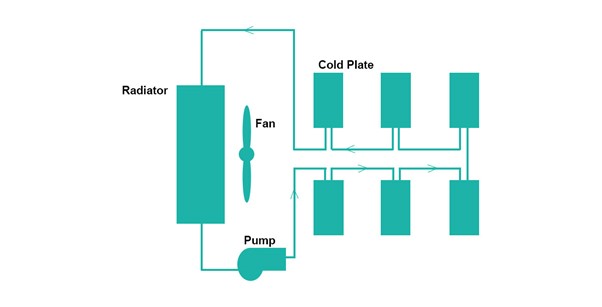As electric vehicles (EVs) go from being a niche product to being widely available, and the usability differences between EVs and their internal combustion engine (ICE) equivalents become more pronounced, consumers, automakers, governments, and fire departments continue to have some safety concerns.
Among these, battery fires due to overheating and explosion accidents have received a lot of media attention regarding battery thermal safety issues in EVs.
To overcome the anticipated difficulties and ensure battery safety, the most recent developments in battery thermal management (BTM) are being pursued.
The BTM technology enhances battery safety by strengthening the heat transfer process, which ensures battery performance based on the battery’s thermokinetic, electrochemical, and mechanical characteristics in both normal and abnormal operating conditions. It is critical to prevent overheating and uphold a comfortable working temperature.

A battery thermal management system is a device responsible for the management of heat dissipation during the electrochemical processes in the cells, allowing efficient and safe use of the battery. The major objective is to prevent accelerated battery deterioration by managing the heat generated by its components for continuous operation at optimum temperature.
Therefore, creating an EV battery thermal management system that is safe and dependable is crucial for the efficient operation of electric vehicles.
Moreover, owing to the rising demand for electric vehicles and the increasing popularity of high-tech urban transportation services such as smart mobility as a service, the automotive battery thermal management system market is expected to grow significantly.
According to the BIS Research report, the battery thermal management system market for mobility and consumer electronics was estimated to be at $4,462.47 million in 2021, which is expected to grow at a CAGR of 23.07% and reach $31.01 billion by 2031.
Find more details on this report in this FREE sample
In this article, a thorough analysis of BTM with improved safety is discussed further.
Importance of EV Battery Thermal Energy System
Future battery models in electric vehicles are anticipated to reach even bigger battery capacities, which may result in the battery heating up dramatically. Currently available electric vehicles include the most recent technology with the potential of quick charging. Due to the closely packed electric charges in today’s newly created lithium-ion batteries, they are also vulnerable to quick heating.
Furthermore, the lithium-ion battery life cycle is shortened, and the danger of thermal runaway in batteries increases when temperatures rise because of heat dissipation.
As cooling during charging improves the efficiency of charge transfer and lessens battery deterioration, it is crucial to have an effective cooling system to regulate battery temperature during fast charging and high current density batteries.
Hence, new battery housing designs, coolants, immersion-cooled batteries, and thermal interface materials are being developed as part of the development of improved battery thermal management systems.
Advancements in Battery Thermal Management Technology
There are three main cooling technologies that use advanced electronic materials for the development of BMT systems. These technologies are discussed in detail as follows:
1. Air Cooling and Heating Technology: Due to its commercial availability, reduced cost, and simplicity of use, air cooling and heating technology is one of the most used technologies. In this mechanism, a fan, a few inlets, and outlets from which air enters and departs the system make up the air conditioning and heating setup.

Airflow is employed to cool down the series-connected batteries by absorbing the heat they emit, and hot air is then discharged from another vent as soon as the air enters through the inlets. Most of the air drives the entire system.
2. Liquid Cooling and Heating Technology: Liquid cooling is a popular method for traction drives and inverters’ thermal management. Due to its higher heat capacity and capacity to control fluid flow to suit the need for heat removal, using a liquid coolant to remove waste heat may be more efficient than the air cooling method.
The liquid cooling process has two different configurations. First, a direct liquid or dielectric liquid cooling, such as mineral oil, can come into direct contact with the battery cells. The other type of liquid is direct liquid or indirect-contact liquid, which can contact the battery cells by implication, such as a combination of water and ethylene glycol.
Between the two, indirect contact frameworks are preferred because they can better contain environmental variables from the battery module, which leads to the superior performance of EVs.
3. Refrigerant Cooling and Heating Technology: A refrigerant system that uses a refrigerant directly as a heat transfer fluid and circulates it throughout the battery pack makes up the refrigerant-based battery thermal management system. Automotive battery systems today use the most cutting-edge thermal management techniques for refrigerant batteries.
Thermal plates are frequently used in refrigerant-based cooling and heating systems to deliver heating or cooling. As the temperature remains nearly constant during phase change for low-pressure decreases, the phase change of the refrigerant in the thermal plate gives excellent heat transfer coefficients and homogenous cell temperatures. However, for water condensation to avoid damaging the thermal plate under high humidity levels, the thermal plate and tubing must be able to withstand higher system pressure.
Conclusion
The purpose of developing an efficient battery thermal management system using advanced technologies is to remove the heat dissipated from the battery due to the electrochemical process, resulting in reducing the battery thermal runaway and increasing the battery life while ensuring personal safety.


